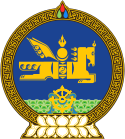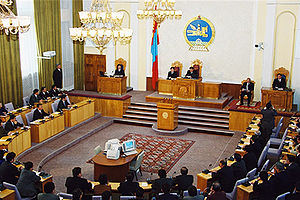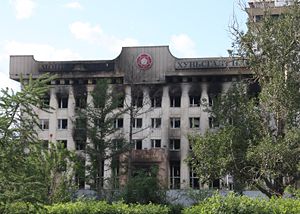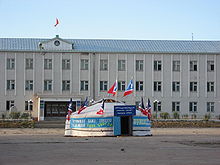- Politics of Mongolia
-
Mongolia 
This article is part of the series:
Politics and government of
Mongolia- Constitution
- President (List)
- Prime Minister (List)
- Sükhbaataryn Batbold
- State Great Khural
- Speaker
- Supreme Court
- Political parties
- Elections
- Aimags (provinces)
- Sums (districts)
- Human rights
- Foreign relations
Politics of Mongolia takes place in a framework of a semi-presidential representative democratic republic, and of a multi-party system. Executive power is exercised by the government. Legislative power is vested in both the government and parliament. The Judiciary is independent of the executive and the legislature.
Contents
Political developments
Until 1990, the Mongolian Government was modeled on the Soviet system; only the communist party—the MPRP--officially was permitted to function. After some instability during the first two decades of communist rule in Mongolia, there was no significant popular unrest until December 1989. Collectivization of animal husbandry, introduction of agriculture, and the extension of fixed abodes were all carried out without perceptible popular opposition.
The birth of perestroika in the former Soviet Union and the democracy movement in eastern Europe were mirrored in Mongolia. The dramatic shift toward reform started in early 1990 when the first organized opposition group, the Mongolian Democratic Union, appeared. In the face of extended street protests in subzero weather and popular demands for faster reform, the politburo of the MPRP resigned in March 1990. In May, the constitution was amended, deleting reference to the MPRP's role as the guiding force in the country, legalizing opposition parties, creating a standing legislative body, and establishing the office of president.
Mongolia's first multi-party elections for a People's Great Khural were held on 29 July 1990. The MPRP won 85% of the seats. The People's Great Khural first met on 3 September and elected a president (MPRP), vice president (SDP—Social Democrats), prime minister (MPRP), and 50 members to the Baga Khural (small Khural). The vice president also was chairman of the Baga Khural. In November 1991, the People's Great Khural began discussion on a new constitution, which entered into force February 12. In addition to establishing Mongolia as an independent, sovereign republic and guaranteeing a number of rights and freedoms, the new constitution restructured the legislative branch of government, creating a unicameral legislature, the State Great Khural (SGKh).
The 1992 constitution provided that the president would be elected by popular vote rather than by the legislature as before. In June 1993, incumbent Punsalmaagiin Ochirbat won the first popular presidential election running as the candidate of the democratic opposition.
As the supreme government organ, the SGKh is empowered to enact and amend laws, determine domestic and foreign policy, ratify international agreements, and declare a state of emergency. The SGKh meets semiannually. SGKh members elect a chairman and vice chairman who serve 4-year terms. SGKh members are popularly elected by district for 4-year terms.
Until June 27, 2004, the predominant party in Mongolia was the ex-communist party Mongolian People's Revolutionary Party or MPRP. The main opposition party was the Democratic Party or DP, which controlled a governing coalition from 1996 to 2000.
From 2000 to 2004 MPRP was back in power, but results of the 2004 elections required the establishing of the first ever coalition government in Mongolia between the MPRP and MDC (Motherland Democratic Coalition).
In January 2006, MP Tsogtyn Bataa changed sides from the Motherland Party to the MRPR, giving the latter exactly 50% of the seats. This gave the MPRP the opportunity to withdraw from the coalition, and, with support of several small parties and defectors from the Democratic party, elect Miyeegombyn Enkhbold as the new prime minister. The events triggered strong protests from civic groups and their followers. Individuals and organizations raised concerns that the government change might have been unconstitutional, but no specific violations could be shown.
In April 2006, Tsakhiagiyn Elbegdorj was elected as a Democratic Party chairman by the two step elections of the party.
In October 2007, Enkhbold lost his position as MPRP chairman to Sanjaagiin Bayar. The MPRP delegates also voted for having Bayar create a new government.[1] Enkhbold remained in office[2] until Bayar was elected on 22 November 2007.[3]
In Bayar's government, Enkhbold was appointed as Deputy Prime Minister on December 5, 2007.[4]
The MPRP won a clear majority (46 of 76 seats) in legislative elections on June 29, 2008. The Democrats (DP) won 27 seats with the three remaining seats going to minor parties and an independent. After intermediate results were published on July 30, DP chairman Elbegdorj declared that the elections were rigged and that his party would not accept the results. Protests against the election results turned violent on the evening of July 1, and protesters sacked the MPRP headquarters in downtown Ulaanbaatar. Five protesters[5] were killed, and around midnight a four-day state of emergency was declared.
Executive branch
Main office holders Office Name Party Since President Tsakhiagiin Elbegdorj DP 18 June 2009 Prime Minister Sükhbaataryn Batbold MPRP 29 October 2009 The presidential candidates are nominated by parties in the State Great Khural and from these candidates the president is elected by popular vote for a four-year term. The president is the head of state, commander in chief of the armed forces, and head of the national security council. He is popularly elected by a national majority for a 4-year term and limited to two terms. The constitution empowers the president to propose a prime minister, call for the government's dissolution, initiate legislation, veto all or parts of legislation (the State Great Khural can override the veto with a two-thirds majority), and issue decrees, which become effective with the prime minister's signature. In the absence, incapacity, or resignation of the president, the SGKh chairman exercises presidential power until inauguration of a newly elected president.
The government, headed by the prime minister, has a 4-year term. The prime minister is nominated by the president and confirmed by the SGKh. The prime minister chooses a cabinet, subject to State Great Khural approval. The Cabinet consists of thirteen ministries.[6] Dissolution of the government occurs upon the prime minister's resignation, simultaneous resignation of half the cabinet, or after a State Great Khural vote for dissolution.
The MPRP and a coalition of opposition parties currently rule in a national unity coalition after they both got the same number of seats in 2004. In July 2005 the Mongolian People's Revolutionary Party (MPRP) announced a unilateral end to the Grand Coalition Government, and that it was assuming the full power of government. After a series of negotiations, the MPRP elected to allow the government of Prime Minister Ts. Elbegdorj to remain in power until August 2006, when Deputy Prime Minister Ulaan is schedule to take the Prime Ministership for the remaining two years of the term.
Ministries
- Foreign Affairs
- Finance
- Justice and Internal Affairs
- Environment
- Defense
- Education, Culture, and Science
- Construction and Urban Development
- Fuel Energy
- Roads, Transport, and Tourism
- Social Welfare and Labor
- Industry and Commerce
- Food and Agriculture
- Health[7]
Legislative branch
The State Great Assembly (Ulsyn Ikh Khural) has 76 members, elected for a four year term in single-seat constituencies.
Political parties and elections
Ger set up by the Democratic Party for an election campaign in Khövsgöl, 2006 For other political parties see List of political parties in Mongolia. An overview on elections and election results is included in Elections in Mongolia.
For other political parties see List of political parties in Mongolia. An overview on elections and election results is included in Elections in Mongolia.Summary of the 20 May 2005 Mongolian presidential election results Candidates – Nominating party Votes % Nambaryn Enkhbayar – Mongolian People's Revolutionary Party 495,730 54.2% Mendsaikhany Enkhsaikhan – Democratic Party 184,743 20.2% Bazarsad Jargalsaikhan – Republican Party 129,147 14.1% Badarch Erdenebat – Motherland Party 105,171 11.5% Total (turnout 74.9%) 914,791 100.00% Source: Adam Carr Summary of the 27 June and 17 July 2004 Mongolian State Great Khural election results Parties Votes % Seats Mongolian People's Revolutionary Party (Mongol Ardyn Khuv'sgalt Nam) 517,443 48.23 37 Motherland Democratic Coalition (Ekh Oron-Ardchilsan) - Democratic Party (Ardchilsan Nam)
- Motherland Party (Ekh Oron Nam)
- Civic Will Party (Irgenii Zorig Nam )
474,977 44.27 35 Independents 36,543 3.41 3 Republican Party (Bügd Nairamdakh Nam) 14,819 1.38 1 Others 28.814 2.69 — Total (turnout 82.2 %) 1,072,596 100.00 76 Source: IPU Summary of the 29 June 2008 Mongolian State Great Khural election results Parties Votes % Seats Mongolian People's Revolutionary Party1 (Mongol Ardyn Khuv'sgalt Nam) 914,037 52.67% 45 Democratic Party (Ardchilsan Nam) 701,641 40.43% 27 Civic Will Party (Irgenii Zorig Nam ) 34,319 1.97% 1 Civic Coalition (Irgenii Evsel) 24,806 1.42% 1 Independents 60,320 3.47% 1 Total (turnout 74.31%) 1,735,123 100% 76 Source: IPU[8] 1Later changed to Mongolian People's Party.
Legal system
The new constitution empowered a General Council of Courts (GCC) to select all judges and protect their rights. The Supreme Court is the highest judicial body. Justices are nominated by the GCC and confirmed by the SGKh and president. The court is constitutionally empowered to examine all lower court decisions—excluding specialized court rulings—upon appeal and provide official interpretations on all laws except the constitution.
Specialized civil, criminal, and administrative courts exist at all levels and are not subject to Supreme Court supervision. Local authorities—district and city governors—ensure that these courts abide by presidential decrees and SGKh decisions. At the apex of the judicial system is the Constitutional Court of Mongolia, which consists of nine members, including a chairman, appointed for 6-year terms, whose jurisdiction extends solely over the interpretation of the constitution.
Administrative divisions
Mongolia is divided in 21 Aimags (provinces) and 1 municipality (hot); Arkhangai, Bayan-Ölgii, Bayankhongor, Bulgan, Darkhan-Uul, Dornod, Dornogovi, Dundgovi, Govi-Altai, Govisümber, Khentii, Khovd, Khövsgöl, Ömnögovi, Orkhon, Övörkhangai, Selenge, Sükhbaatar, Töv, Uvs, Zavkhan.
Local khurals are elected by the 21 aimags plus the capital, Ulaanbaatar. On the next lower administrative level, they are elected by provincial subdivisions and urban subdistricts in Ulaanbaatar
See also
References
- ^ "Aktuelle Nachrichten aus der Mongolei/ 22. bis 28. Oktober 2007". mongoleionline.de. 2007-10-28. http://www.mongolei.de/news/2007okt4.htm. Retrieved October 30, 2007.
- ^ "Mongolian parliament accepts PM's resignation", Xinhua (china.org.cn), November 8, 2007.
- ^ "Mongolia rushes to appoint new prime minister as a budget deadline looms", Associated Press (International Herald Tribune), November 22, 2007.
- ^ "Mongolian Parliament approves new coalition government", IST, AFP (Times of India), December 6, 2007.
- ^ "Fatal clashes in Mongolia capital". London: BBC World News. http://news.bbc.co.uk/2/hi/programmes/from_our_own_correspondent/7860539.stm. Retrieved July 2, 2008.
- ^ Montsame News Agency. Mongolia. 2006, Montsame News Agency Foreign Service Office, ISBN 9992906278, p. 43
- ^ Montsame News Agency. Mongolia. 2006, Montsame News Agency Foreign Service Office, ISBN 9992906278, p. 44
- ^ Results of the Mongolian legislative election, 2008
External links
- (English) (Russian) Official Website of the Government Organizations of Mongolia
- Erik Herron's Guide to Politics in East Central Europe and Eurasia
Politics of Asia Sovereign
states- Afghanistan
- Armenia
- Azerbaijan
- Bahrain
- Bangladesh
- Bhutan
- Brunei
- Burma (Myanmar)
- Cambodia
- People's Republic of China
- Cyprus
- East Timor (Timor-Leste)
- Egypt
- Georgia
- India
- Indonesia
- Iran
- Iraq
- Israel
- Japan
- Jordan
- Kazakhstan
- North Korea
- South Korea
- Kuwait
- Kyrgyzstan
- Laos
- Lebanon
- Malaysia
- Maldives
- Mongolia
- Nepal
- Oman
- Pakistan
- Philippines
- Qatar
- Russia
- Saudi Arabia
- Singapore
- Sri Lanka
- Syria
- Tajikistan
- Thailand
- Turkey
- Turkmenistan
- United Arab Emirates
- Uzbekistan
- Vietnam
- Yemen
States with limited
recognition- Abkhazia
- Nagorno-Karabakh
- Northern Cyprus
- Palestine
- Republic of China (Taiwan)
- South Ossetia
Dependencies and
other territories- Christmas Island
- Cocos (Keeling) Islands
- Hong Kong
- Macau
Categories:
Wikimedia Foundation. 2010.




